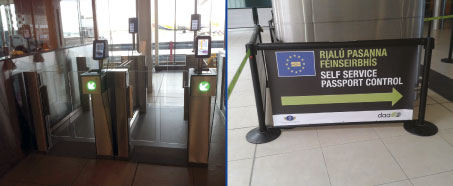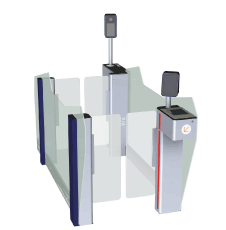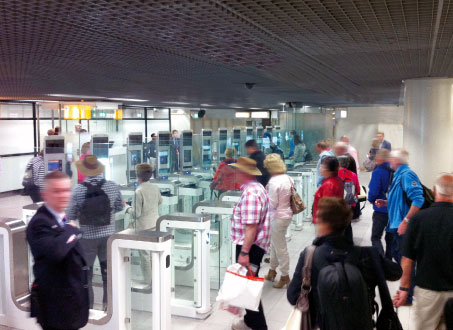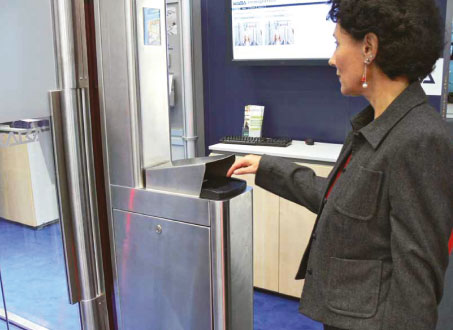
The Irish Naturalisation and Immigration Service and Dublin Airport Authority are collaborating on a pilot of automated border control gates at Dublin Airport.
Improved passenger flow and shorter queues at immigration can have an important beneficial impact on airport efficiency and the passenger experience.
“The main trend developing is indeed the optimisation of passenger processes,” confirmed Ute Nellen, Head of Marketing Communication, Strategic Marketing, Kaba Gallenschütz. “Increasing self-service and providing more automated solutions at immigration can reduce queues and simplify processes for the passengers. This is an area where there is room for improvement in the industry. Generally there is still a lot of room for passenger self-service in airports. There needs to be more convergence, too – the sharing of information between airports, airlines and authorities. Using biometrics for identification could lead to more secure, more comfortable and faster processes.”
Kaba’s automated border control unit is comprised of a barrier system with an internal document reader and an external biometric device. Its ability to scan both passports and biometrics means that staff workload is reduced, document fraud is better prevented and, most importantly, waiting times at border control are reduced. Nellen explained that if verification fails, the passenger is led directly to the manual passport control without blocking the passenger flow.
DAA pilots automated border control

Ute Nellen, Head of Marketing Communication, Strategic Marketing, Kaba Gallenschütz: “Increasing self-service and providing more automated solutions at immigration can reduce queues and simplify processes for the passengers.”
A pilot is underway of self-service immigration control at Dublin Airport, where the Irish Naturalisation and Immigration Service and Dublin Airport Authority are collaborating on the introduction of automated border control gates. The pilot will last until October. As part of this project, SITA’s iBorders biometric gates, which are provided by Kaba, use the latest biometric technology to identify each passenger through facial recognition. They rapidly verify that the passenger is the passport holder and is authorised to access the country. They are currently processing up to 1,000 passengers per day, in as few as 7.5 seconds each. Alan Shatter, Minister for Justice, Equality and Defence, commented: “Border control arrangements at Dublin Airport are currently undergoing major change. Immigration control processes are being reviewed and leading-edge border technology such as automated gates is being tested. Many major European airports are adopting a similar trend towards the deployment of automated gates for immigration control functions to enhance passengers’ experience on arrival at airports while also strengthening border security. The trial period will test the suitability of e-gates for use at Dublin airport with a view to providing a more secure and efficient means for clearing passengers through immigration control. I look forward to receiving recommendations on the future use of such technology on conclusion of the trials.”
A core element in this solution is NEC’s NeoFace face recognition software, which is designed to provide high accuracy and selectivity regardless of the database size and image quality. This, combined with the gates provided by Kaba, results in a seamless experience for the passenger.

Nuno Periquito, Marketing Manager, Vision-Box. “What we are seeing more and more, is airports adopting automated border control technology in order to assure stronger border integrity but at the same time provide a more pleasant and positive passenger experience.”
Dan Ebbinghaus, SITA Vice President, Government Solutions, said: “SITA has extensive experience in dealing with the challenges facing border control authorities around the globe; in the region of 30 governments use our iBorders systems to keep their borders secure. Our gates in use in Dublin provide a fast and seamless experience for the passenger. Importantly, because they combine our air transport industry experience and market knowledge with the fastest and most accurate face recognition software in the market, they also ensure accuracy and speed for border control and airport authorities.”
To both cater to the modern mindset of heightened-security, whilst also working towards a quicker process, in 2006 Vision-Box became the first company in Europe to deploy automated border control eGates at an airport. These eGates are based on face matching verification against ePassports. “This use of biometrics is clearly one of the strongest trends today in terms of airport innovation. The passenger biometric validation only occurs at the border level, but expanding its use across the whole journey will empower the passenger in terms of self-service since the identification is automatic and gifts authorities a better control of the infrastructure,” commented Nuno Periquito, Marketing Manager for Vision-Box. “What we are seeing more and more, is airports adopting automated border control technology in order to assure stronger border integrity but at the same time provide a more pleasant and positive passenger experience.”
In January, Vision-Box celebrated the passage of one million travellers through its automated border control e-Gates at Amsterdam Airport Schiphol. There are a total of 36 units at the airport, located in the Departure 3, Arrival 3 and transit areas between Schengen and non-Schengen. Vision-Box is also responsible for the gates transaction manager platform, which controls how they operate, defines the associated business rules and border checks processes.
Miguel Leitmann, Senior Vice President of Vision-Box S.A. explained that the large number of passengers that have passed through the automated border control e-Gates reinforces the idea that this is the beginning of a new paradigm shift being witnessed in airports worldwide. “Border control today has evolved to a point where we can clearly improve the passenger experience, not only by facilitating the border crossing process but also by making it as simple as possible, while still maintaining the security level required by border control agencies,” he said.

Kaba’s automated border control unit is comprised of a barrier system with an internal document reader and an external biometric device.
“Using biometrics – facial recognition, iris recognition, or fingerprint recognition – as the identification token, it is possible to consolidate the passenger information at each interaction and check, for example, if the person boarding went through border control,” added Periquito, while Kaba’s Nellen summed it up as “Three words: Security, speed and simplification.”







